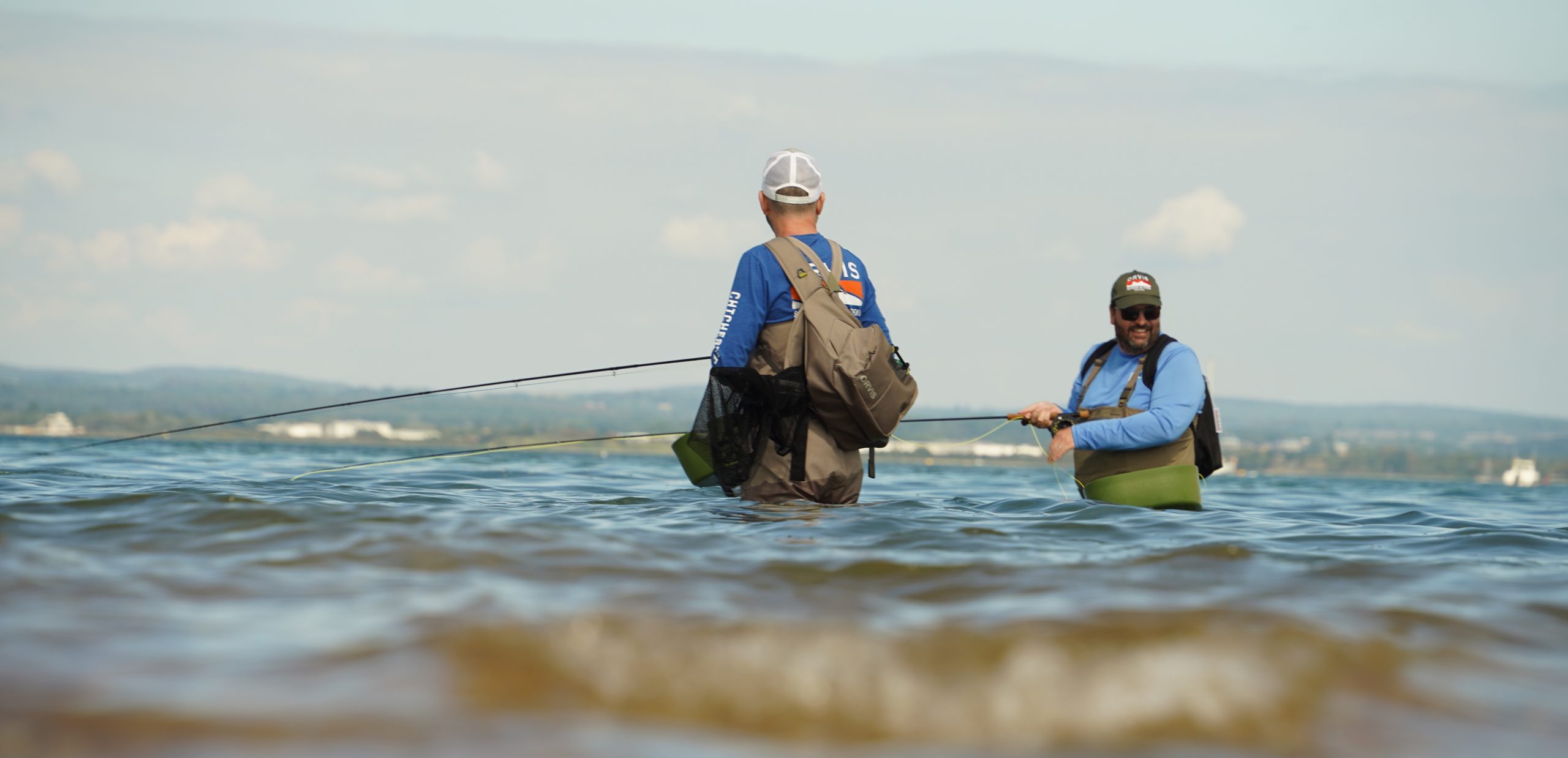
Fly fishing for mullet | A masterclass with Colin Macleod
I was lucky to get to attend a Mullet on the Fly Masterclass held by Colin Macleod, a pioneer of saltwater fly fishing. This was run as part of the Orvis Saltwater Fly Fishing Festival 2023, on Hayling Island. It was fascinating to learn from Colin, who has such a deep understanding of this species and its feeding behaviour. For more information than is included in this guide, you can order his book.
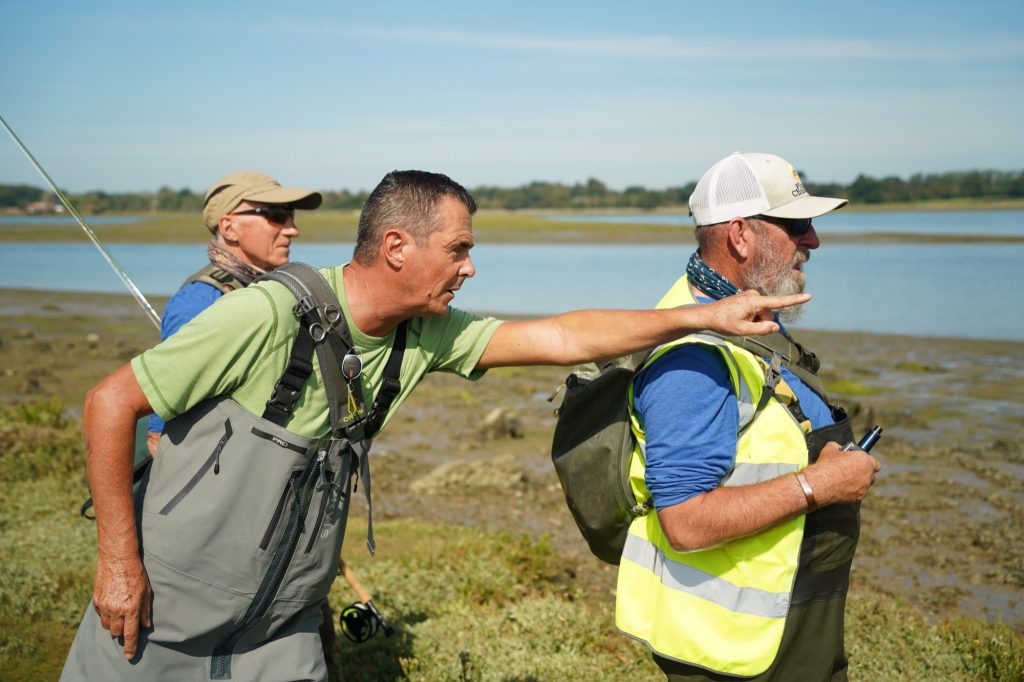
In Pursuit of Wild Fish…
“I was about ten when I first went fishing with my dad. We were up in North Scotland, going after the wild trout in our local rivers. That was me hooked, and but when we moved way down south, the local stocked trout lakes just didn’t have that same wild feel. Initially, I started off fishing for bass to find some wild fish on the fly. But there were clearly lots of big mullet around, and that got my attention.”
“In the early 2000’s, I’d drive back to North Scotland just for the fishing. I’d take my daughters up to see their city friends, then keep driving north to the rivers of my youth…”
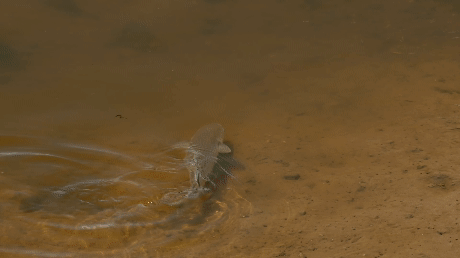
“Around that time, folks on online forums were saying that chasing mullet with flies was a lost cause. It was a stroke of luck that on my first cast saltwater fly fishing, I caught one. I was using a flexi-floss blood worm, which is pretty much a trout fly. It took me another five months to land my second mullet, highlighting just how tricky they are to bring to the net.”
For Colin, this experience of not catching mullet for five months only spurred him on to try to figure these fish out. That first fish had left a lasting impression…
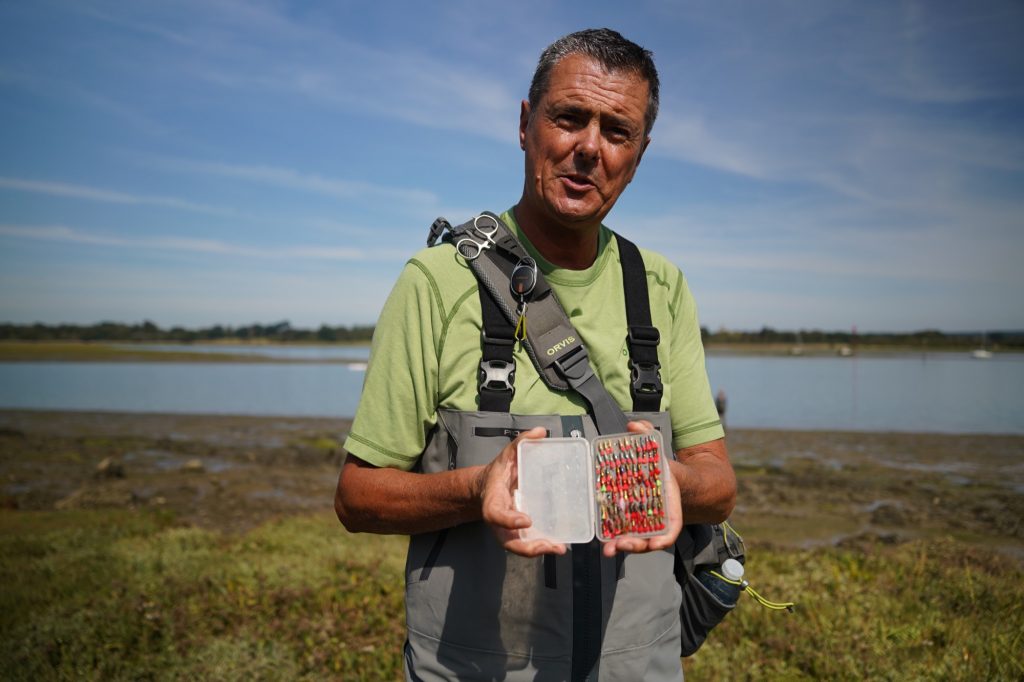
Saltwater fly set up for mullet
Rods and Lines
“For tackle, it’s best to keep it simple. Use a normal trout rod, ideally in the 5-6 weight range. A floating line is a must-have, especially in these shallow waters. While some anglers may use saltwater-specific 6-weight rods, a good freshwater 5-weight rod like the Greys Streamflex is perfectly suited for the job.”
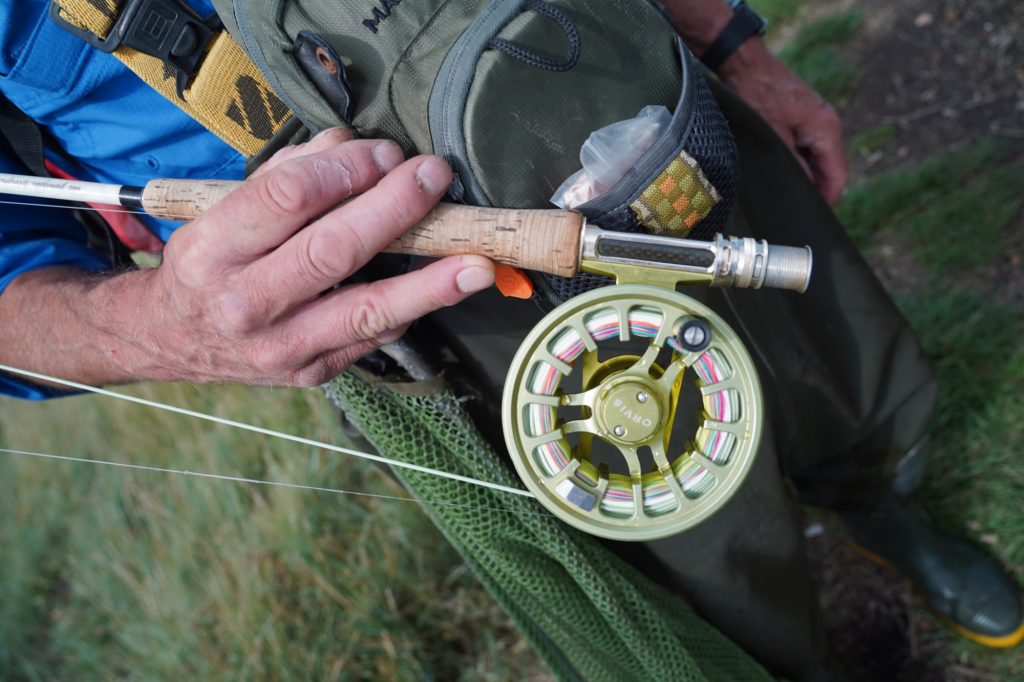
Leaders for mullet
I asked Colin about leaders, and he showed me his.
On the end was a tapered leader, starting at about 8lb breaking strain. It must be flourocarbon, not monofilament line. This is because monofilament line floats on the surface at this breaking strain when it coils. Fluouro is better at sinking. This is important, as one of the key things that spooks mullet is the sight of a leader coiling on the surface. Fly lines do not appear to deter the fish, nor does the sight of anglers when they’re really feeding. Colin told me fish will be practically feeding around his feet at times. The way light passes through transparent leaders creates flashing on the surface which seems to spook the mullet.
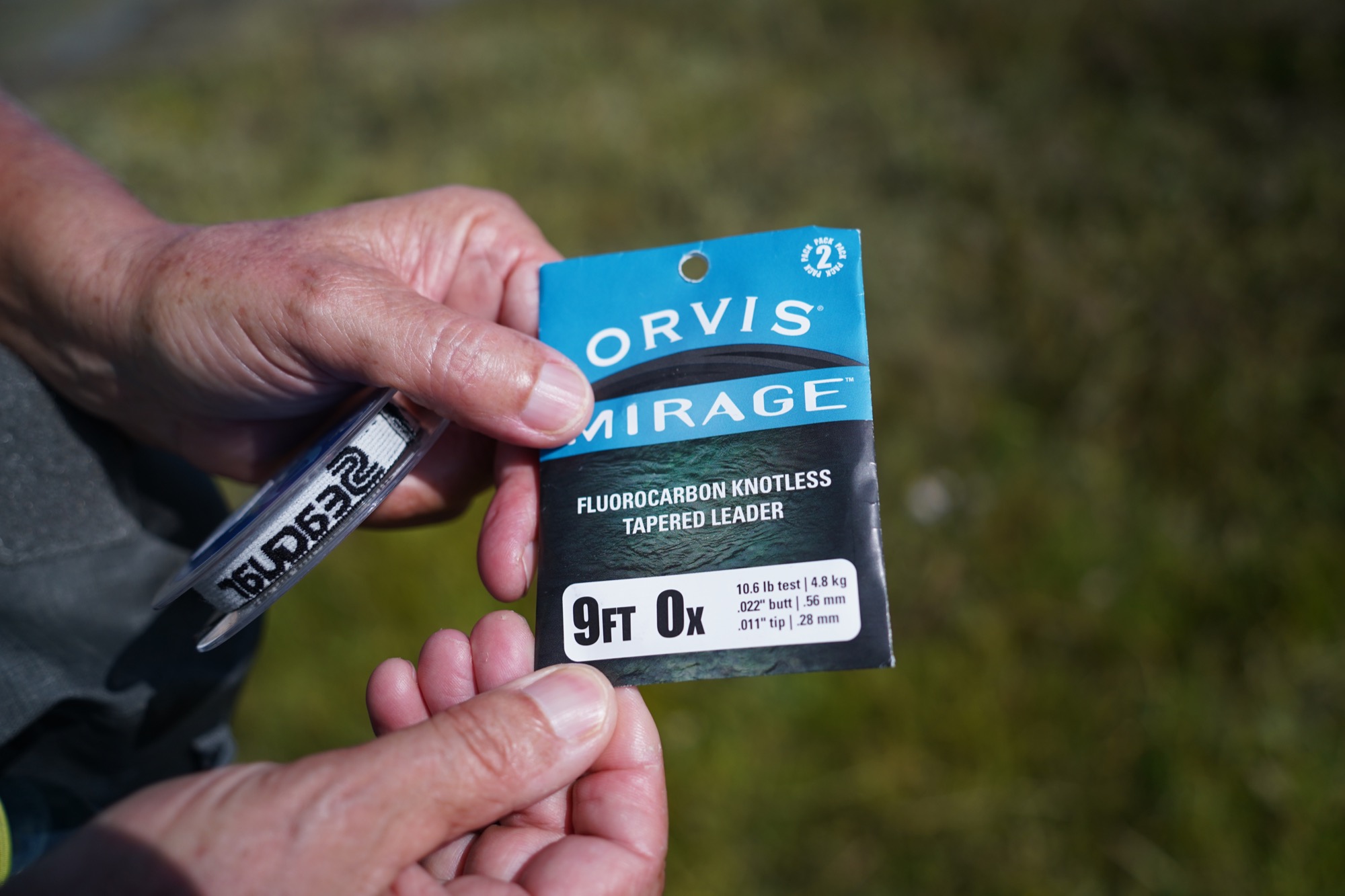
On the end of this tapered line, Colin uses a 10lb fluorocarbon leader. He says that he’s experimented with lighter lines but found that mullet snap him off. They are very powerful fish. I suspect that if you’re fishing in heavy structure around boats and pontoons, it may sometimes be necessary to put a fair bit of pressure on a fish to slow down a run. This requires heavier lines.
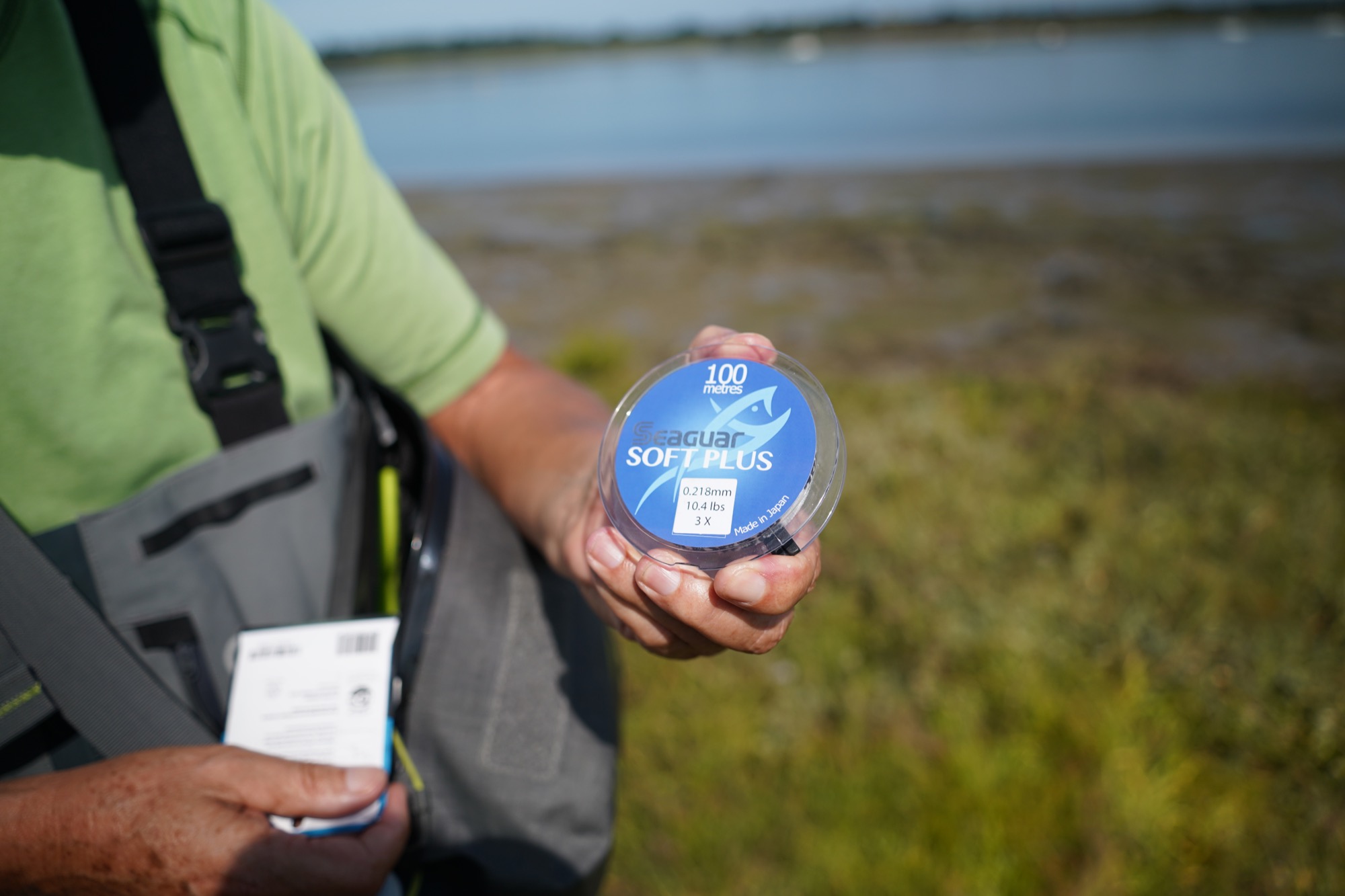
Mullet flies
Colin explained that he has flies designed to imitate rag worm and mud shrimp. These are two morsels that mullet are known for feeding on. The ragworm flies come in a few different forms. Some of them are longer and more hair-like in the red colour, which holds a fascination for mullet. Others are shorter and ‘hairy’ to imitate the little projections that ragworm have. The little projections along the sides of a ragworm are called parapodia. These are paired, fleshy appendages that extend from each body segment. The level of attention to detail that Colin has gone to here to replicate the natural food sources of the mullet is rather extreme.
The second type of fly he showed me were his mud and sand shrimp imitations. Many of these have a shine to them, but none of them are silver. There is a noticeable absence of fish imitations amongst his flies.
Instead of imitating fish, Colin’s approach is to imitate the little morsels that drift out of streams and overflows into estuaries. Lures can be fished static or retrieved fairly slowly, and he has different flies for each method.
What I found fascinating was how Colin catches such large bass on these incredibly tiny flies. My experience lure fishing has been that bass far more readily hit big lures in the 5″+ range. I’ve fished with ultra light Japanese lure rods for years and not caught big bass, and only started catching when I scaled up tackle. This has not been Colin’s experience…
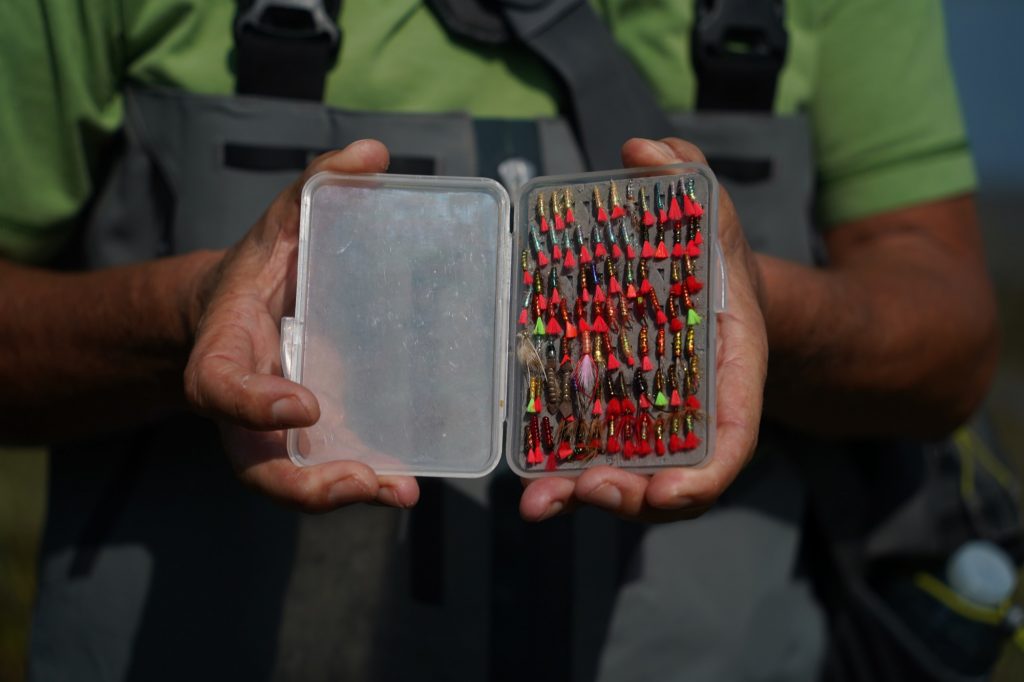
The best mullet flies: Diawl Bachs, Ghostbusters, and Spectra Shrimp
“For dead drifting, diawl bachs work exceptionally well. These traditional trout flies feature blue peacock feathers as a tail and two red glass beads for the head. Another effective fly is the ghostbuster, which is great for shallow waters.”
For those new to fly fishing, dead drifting refers to allowing flies to float naturally, letting the current do the work for you. In a saltwater environment, that might be the tide, the wind or water from a stream or outflow. Just like with trout, the goal is to avoid ‘drag’ where your line pulls the fly unnaturally across the surface.
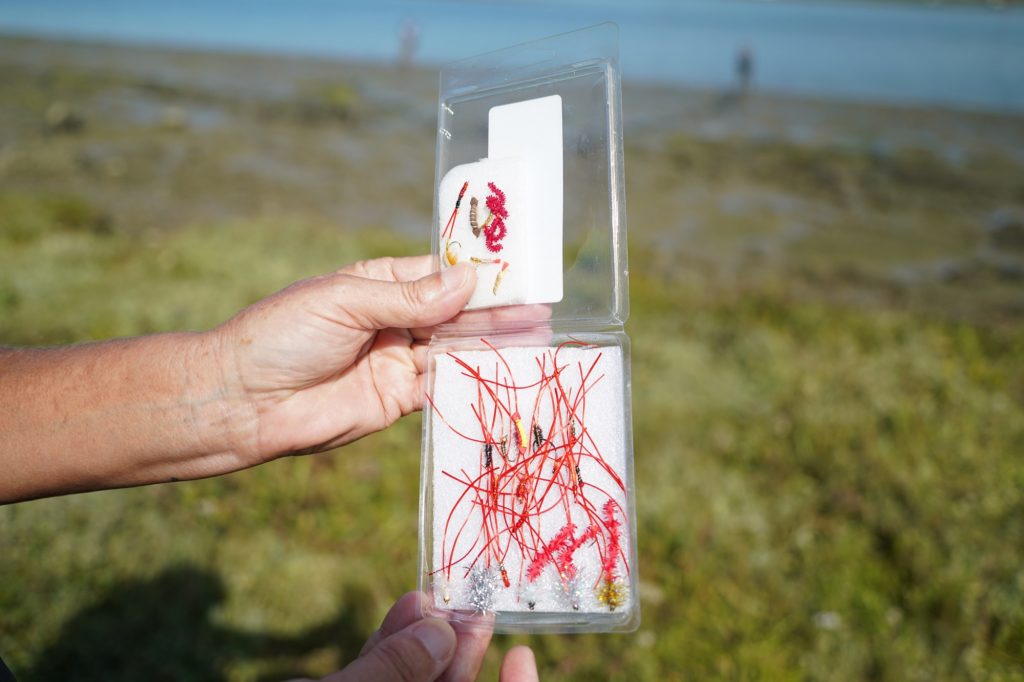
Flies that Mullet Will Chase: The Red Tag and More
Colin has another set of flies that he uses with a slow retrieve, to encourage mullet to chase.
“There’s the spectra shrimp, a fly I created that’s both bright and effective. Unlike most other flies, mullet will actually chase after it. Another fly that mullet are prone to chasing is the red tag, a traditional fly dating back to the 18th century. When fishing in still water with no current, a very slow retrieve using a spectra shrimp, red tag, or even a diawl bach is recommended.”
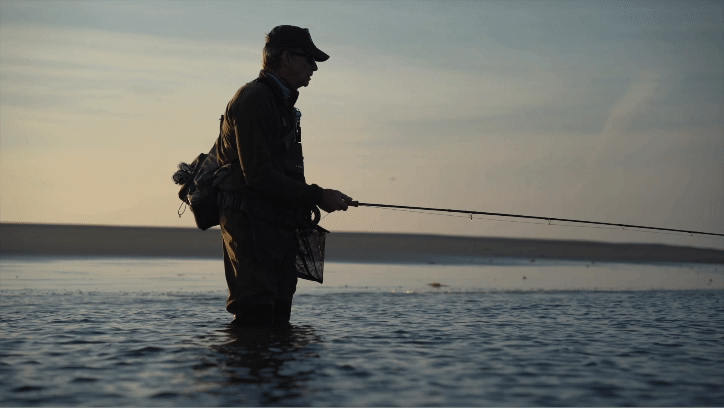
Mullet on the fly technique
Casting and Strategy
Apparently, when it comes to casting, less is more. Colin says, “You don’t need long casts. In fact, a subtle approach is required. Heavier 9-weight lines could easily spook the fish. The aim is to get your flies in the water while causing as little disturbance as possible.”
Detecting Feeding Shoals
Finding where the fish are feeding is crucial. Colin advises, “The key is to locate feeding shoals. These fish show unmistakable signs when they are feeding; they become animated, moving quickly and displaying silver flashes as they turn on their sides to feed. That’s the signal to get your flies among them for an almost certain hook-up.”
Setting the Hook
Setting the hook with mullet is not the same as trout, nor is it true that mullet have soft mouths. Colin’s guidance is to keep your fly line tight and watch for any movement at the end of it. If you see any, give a gentle strip strike to set the hook. Don’t lift the rod like you would for trout; mullet have a tough upper lip, and you won’t set the hook properly, likely losing the fish on the first run.
Watch out for expensive snags
Colin also notes that fishing near yachts could be tricky. He cautions, “However, be mindful of anchor ropes and chains around yachts, as mullet often feed near them. Getting snagged during an intense fight adds an extra layer of excitement to the experience.”
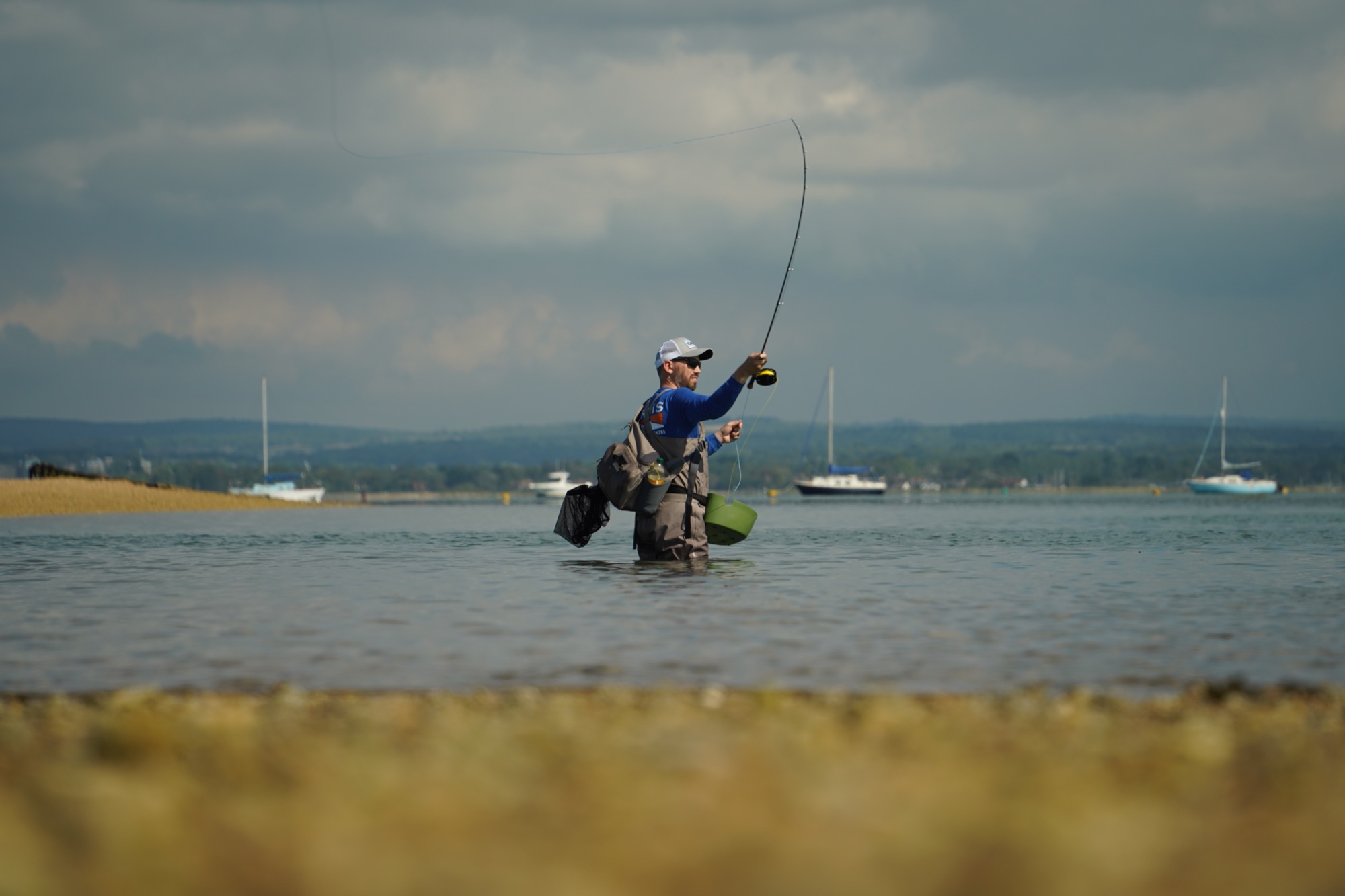
Types of mullet
So, how do you catch a mullet? The first step is locating a fish-rich area. If you find a location with a good population of mullet, you’re already on the right track. Your approach will depend on the type of mullet you find.
Targeting Thick-Lipped Mullet: The Dead Drift Technique
The most common mullet are thick-lipped mullet, typically found around river mouths or estuaries. They feed on incoming tides in currents created by the river flowing into the sea. For them, I employ a “dead drift” technique. This involves using a floating line and presenting flies up-current, letting them drift towards the fish.
Exploring Different Types: Thin-Lipped Mullet
“The second most common type of mullet are the thin-lipped mullet. These mullet favor feeding over mud banks during the flooding tide and are commonly found well up tidal rivers. For instance, in Sussex, you can find them six miles upstream or even more. Freshwater seems to attract them, contrary to what some might think.”
Colin confirmed something I’d already heard from a few others – mullet have predictable routines based on the tide. If you fish an estuary on a certain tide and mullet are fishing in a particular spot, it’s highly likely in a few weeks time if you come back at the same state of tide they will be there again. I must remember to carry a note book to keep track of these details.
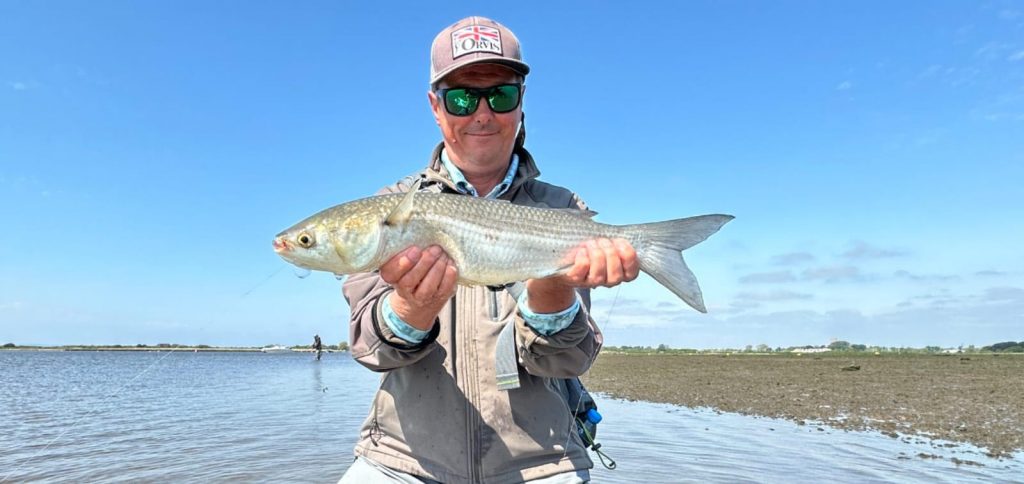
The Thin-Lipped Mullet’s Feeding Habits and Tactics
“Thin-lipped mullet rush into shallow water to feed on mud shrimps (Latin name: Corophium Volutator) during the flooding tide. As the water flows over the mud flats, the mullet have a limited time to feed before the shrimps retreat to their underground burrows. To imitate mud shrimps, two useful flies are the brown flexi shrimp and the aptly named mud shrimp. A simple casting and quick stripping technique can yield good results.”
This is the style of fishing we were doing at the Orvis Saltwater Fly Fishing festival. One of the challenges is landing mullet in such shallow water, as it’s getting to be not much deeper that the body of the fish themselves.
River Fishing for Thin-Lipped Mullet
“In rivers, normal tactics like diawl bachs and spectra shrimps might not be effective. However, a technique using Mepps spinners tipped with rag worm or the flexi worm has shown promise. In fact, the flexi worm acted as an attractor, stimulating interest and ultimately catches.”
This is an upgraded version of the traditional method for catching mullet with a regular spinning rod, mepps spinner and small ragworm. FISHMAG has an article about this in a separate guide to mullet fishing.

The Golden Grey Mullet: The Third Variety
The third type of mullet found in the UK is the golden grey mullet, mainly present on sandy beaches in the South of the country, such as Cornwall, Devon, and South Wales.
Techniques for Catching Golden Greys
“The best approach for these mullet is to position yourself behind the shoal, approximately 15 yards away. Flies like the flexi worm are particularly effective for golden greys. If that’s not working or the waves aren’t sufficient to stir up food, you can try other flies like the diawl bach or the spectra shrimp, and use a slow retrieve to attract the fish.”
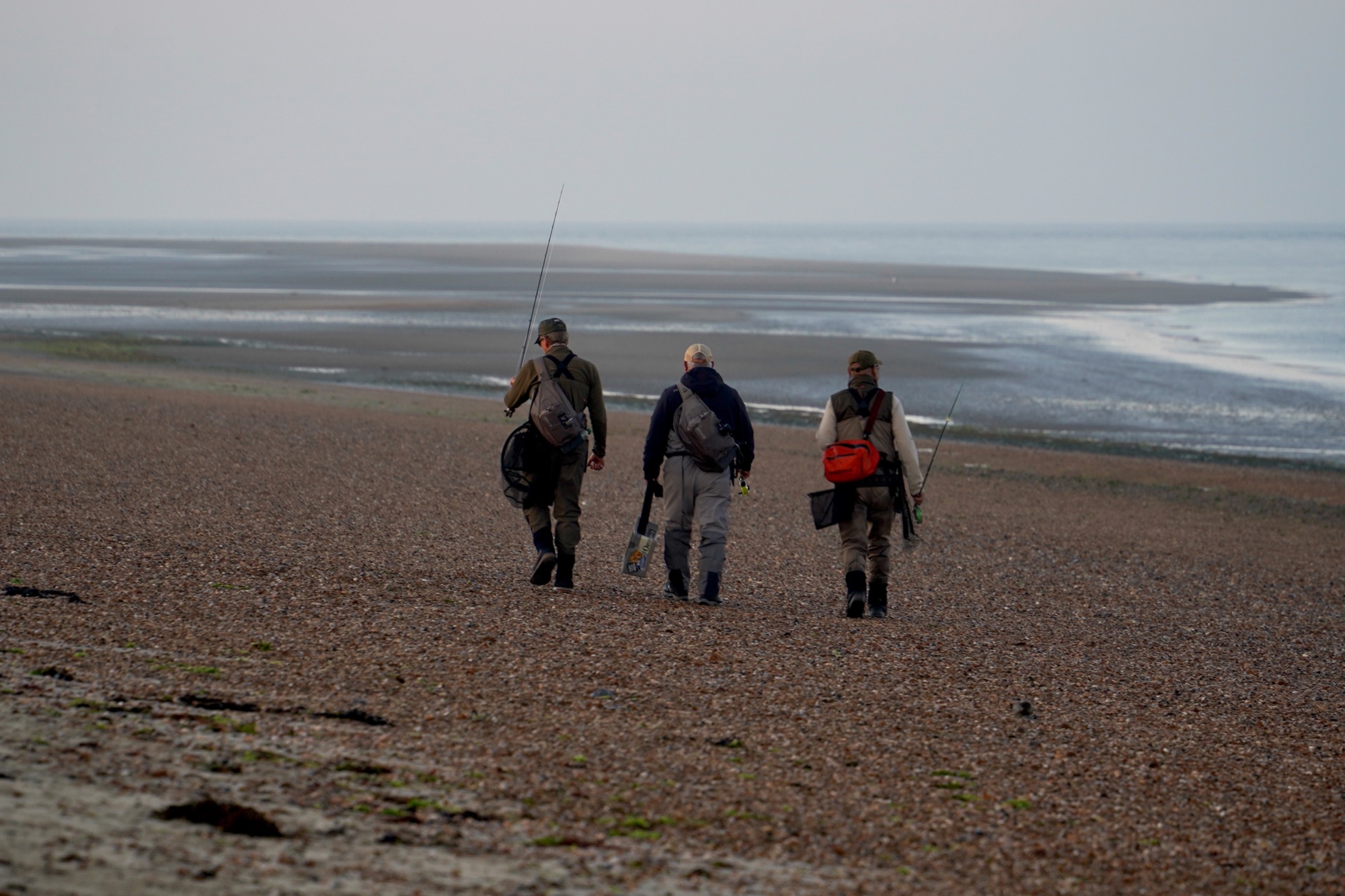
Bonus – discovering the ‘energy drink’ for mullet
Lastly, there is a method Colin has spoken about where all three species of mullet can be caught in the same session. Colin says this method was discovered by Welsh angler Darren Jackson.
For this method to work, you need to be at a beach mark that has a bloom of a particular kind of algae. Thankfully, it’s easy to spot and relatively common around Europe and in the North Sea.
It’s that white foamy stuff that gets left on the beach. Not whitewater, but the slightly greyish brown froth you may be familiar with. Locations with this algae are fertile fishing grounds, and in Colin’s experience it has guaranteed the presence of at least one of the mullet species.
What Darren figured out is that focusing on fish feeding in shallow waters close to the shore was the key. When waves create shallow water tables, fish often conceal themselves in these 6-inch deep zones.
“Darren recommends ignoring the fish that are 20 yards offshore and concentrating instead on those within a few feet of the water’s edge. The strategy involves crawling on hands and knees during the last few yards to take up the right position without spooking the fish. When a new wave rolls in, creating another shallow water table, you should already be in position for sight fishing. This is an incredible opportunity for anglers who enjoy the thrill of stalking and capturing fish up close.”
“Anywhere you find this algae in the UK and the fish that feed on it, you’re likely in for an excellent fishing day. Intriguingly, while the algae is toxic in its white foam state, its brown, decaying form becomes a nutritious “energy drink” for fish, resulting in larger and healthier specimens that put up a fantastic fight.”
Well, there you have it. An extraordinary introduction to saltwater fly fishing for mullet from Colin at Orvis Fly Fishing Festival. A huge thanks to him for sharing this with the FISHMAG community. If you’d like to learn more, you can order Collin’s book here. At the time of writing, Colin is running guided trips in Cuba for bonefish, which he says are great practice for mullet and vice versa.
